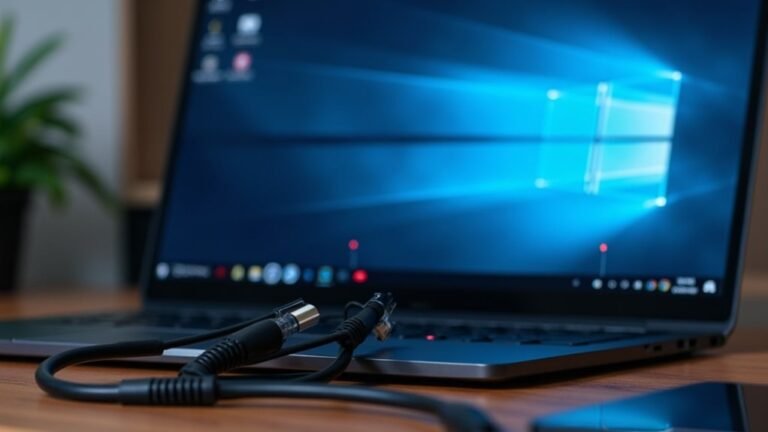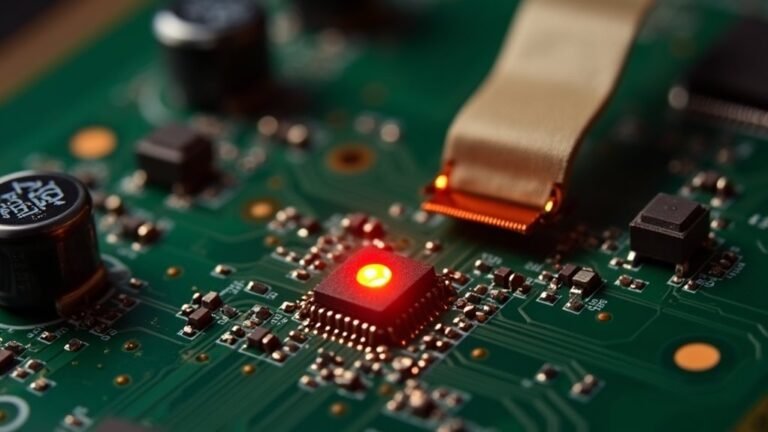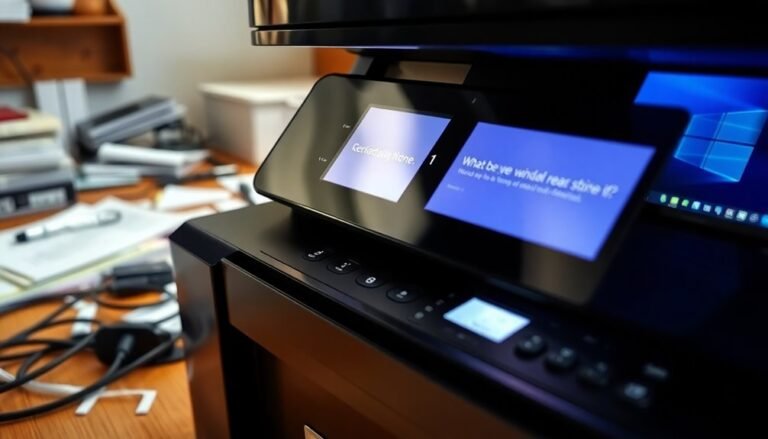Windows 11 Slow SSD: Optimize SSD Performance on Windows 11

To boost your SSD’s speed on Windows 11, start by enabling AHCI in your BIOS and making sure SSD drivers are up to date. Confirm TRIM is active and use the built-in Optimize Drives tool regularly.
Limit startup programs and choose a High Performance power plan. Keep 10-20% free space on your SSD to maintain optimal performance.
Disable indexing to reduce unnecessary disk activity. Monitor disk health with tools like CrystalDiskInfo.
If you want to uncover every tweak and fix for sluggish SSDs, there’s more to explore.
Understanding How SSDS Work With Windows 11

Understanding How SSDs Work with Windows 11: Boost Performance and Extend Lifespan
Solid State Drives (SSDs) offer significant performance advantages over traditional Hard Disk Drives (HDDs), and Windows 11 is fully optimized to take advantage of these benefits. SSDs use NAND flash memory to store data, enabling much faster read and write speeds.
Windows 11 supports NVMe SSDs, utilizing PCIe lanes to deliver superior data transfer rates for faster boot times, application launches, and file transfers.
A key component of SSD technology is the drive’s controller, which manages data placement and implements wear leveling to increase the lifespan of your SSD. Windows 11 enhances SSD performance by automatically executing the TRIM command, which clears unused data blocks and maintains optimal write speeds over time. The Disks & Volumes settings in Windows 11 provide a modern interface for managing and optimizing your SSD, allowing users to format, resize, and monitor their drives with ease.
For maximum compatibility and efficiency, Windows 11 primarily uses the NTFS file system, with ReFS available for specific workloads. Properly formatting your SSD with a supported file system is essential before use.
Windows 11 also includes powerful tools like “Disks & Volumes” and Disk Management console, making it easy to manage, format, and optimize your SSD.
Regularly monitoring storage usage and utilizing built-in cleanup utilities in Windows 11 help keep your SSD responsive and healthy. By understanding how SSDs work with Windows 11 and following best practices, you can ensure optimal performance and extend the life of your storage drive.
Essential BIOS and Driver Settings for Maximum SSD Speed
Maximize Your SSD Speed on Windows 11 with Essential BIOS and Driver Settings
To unlock the full potential of your SSD on Windows 11, properly configuring BIOS and driver settings is crucial. Start by setting your SATA controller to AHCI mode in BIOS, which enables advanced features like Native Command Queuing to significantly enhance multi-threaded SSD performance.
If Windows 11 was installed while the SATA mode was set to IDE, use registry tweaks to activate AHCI drivers before switching BIOS settings to avoid boot failures.
Always prioritize your SSD as the primary boot device and enable UEFI boot mode in BIOS. This not only speeds up startup times but also ensures full compatibility with Windows 11. Confirm TRIM is enabled on your SSD, as this function helps Windows 11 maintain optimum drive performance by efficiently managing unused data blocks.
Disabling legacy boot options such as CSM (Compatibility Support Module) prevents potential boot issues and further optimizes system performance.
Keep your SSD firmware updated by downloading the latest versions from the manufacturer’s website. Additionally, regularly update your motherboard chipset and storage controller drivers to maintain maximum compatibility and SSD speed.
For enhanced responsiveness on some systems, consider disabling onboard VGA and PCIe power-saving features within BIOS.
Fine-Tuning Windows 11 System Settings for SSD Optimization
Optimize Your Windows 11 SSD Performance with These Essential System Settings
Windows 11 is designed with strong default support for SSDs, but you can maximize your SSD’s speed and lifespan by fine-tuning several critical system settings. Here’s how to optimize your Windows 11 SSD for peak performance:
1. Enable Write Caching on Your SSD
Boost write speeds by enabling write caching. Open Device Manager, find your SSD under Disk Drives, right-click and select Properties. Go to the Policies tab and activate write caching. This improves performance but be aware of the slight risk of data loss during unexpected power outages.
2. Ensure TRIM is Active for SSD Optimization
Windows 11 automatically runs scheduled optimization (TRIM) to keep your SSD healthy. Verify it’s enabled by searching “Defragment and Optimize Drives” in the Start menu. Regular weekly optimization helps maintain SSD speed and longevity.
3. Manage Startup Programs to Reduce Disk Load
Speed up boot times and reduce unnecessary disk activity by limiting startup programs. Open Task Manager, navigate to the Startup tab, and disable apps you don’t need at startup.
4. Disable Disk Indexing on Your SSD
Turn off disk indexing to lower constant disk writes. In File Explorer, right-click your SSD drive, select Properties, and uncheck “Allow files on this drive to have contents indexed.” This helps reduce SSD wear and improves responsiveness.
5. Adjust Power Settings for Optimal SSD Health
Switch to the High Performance power plan in Control Panel > Power Options. Under advanced settings, disable “Turn off hard disk after” to prevent your SSD from powering down, which can reduce latency and wear.
6. Disable Hibernation to Save Space and Extend SSD Life
Hibernation uses significant storage and increases write cycles. To disable it, open Command Prompt as an administrator and run the command: `powercfg -h off`. This frees up disk space and helps prolong your SSD’s lifespan.
By applying these Windows 11 SSD optimization tips, you can enjoy faster system responsiveness, longer SSD durability, and a smoother computing experience.
For more guides on Windows 11 performance tuning, stay tuned!
Efficient Data and Space Management on Your SSD
Efficient SSD Data and Space Management Tips for Optimal Performance and Longevity
Managing data and space on your SSD effectively is crucial for maximizing performance and extending your drive’s lifespan. Start by partitioning your SSD using Windows 11 Disk Management to separate system files from user data. This improves organization and speeds up data access. Always back up your data before creating or adjusting partitions to prevent data loss.
Maintain at least 10-20% free space on your SSD. Adequate free space enables the SSD controller to perform wear leveling and garbage collection, which helps sustain high speed and prolongs SSD life. Regularly clean up unnecessary files and uninstall unused applications to prevent your SSD from becoming overly full, which can cause slow write speeds and reduce drive durability.
To extend your SSD’s lifespan further, minimize unnecessary write operations. Reduce paging file usage, disable hibernation, and limit background apps that generate excessive writes. Consider moving frequently updated files, such as browser caches, off your SSD to a secondary storage device.
Key Benefits of Proper SSD Space Management:
- Protect your valuable data from accidental loss
- Keep your SSD running at peak performance levels
- Avoid unexpected slowdowns and premature wear
Implement these SSD management strategies today to enhance your Windows 11 PC’s speed, reliability, and longevity.
Leveraging Built-in Windows Tools for SSD Maintenance

Maximize Your SSD Performance with Built-in Windows 11 Maintenance Tools
To keep your SSD running at peak performance, leverage Windows 11’s built-in maintenance utilities designed specifically for solid-state drives. Start by using the “Defragment and Optimize Drives” tool, which intelligently detects SSDs and applies the TRIM command rather than traditional defragmentation. This process cleans up unused data blocks, maintaining fast write speeds and prolonging your SSD’s lifespan.
Windows 11 schedules this optimization weekly by default, but you can manually trigger it anytime via the drive’s Properties > Tools tab for instant performance boosts.
Ensure that write caching is enabled on your SSD by accessing Device Manager, locating your SSD under Disk Drives, and reviewing the device properties. Write caching stores data temporarily in RAM, reducing write delays and enhancing system responsiveness during intensive tasks.
While disabling write caching may protect data during sudden power loss, it can significantly reduce SSD performance.
Finally, optimize your power settings by selecting a high-performance power plan in Windows 11 Power Options. Choosing “Best Performance” or “Ultimate Performance” mode prevents unnecessary SSD throttling, guaranteeing maximum data throughput and extending your drive’s durability.
Preventing Common Causes of SSD Slowdowns
Prevent Common Causes of SSD Slowdowns to Maximize Performance
Solid State Drives (SSDs) deliver faster speeds and greater reliability compared to traditional hard drives. However, SSD slowdowns can still occur due to several common issues. To keep your SSD running at peak performance, proactive maintenance and proper system configuration are essential.
Here are key steps to prevent SSD slowdowns:
1. Update SSD Firmware and Storage Drivers Regularly
Outdated SSD firmware and storage drivers can significantly reduce drive performance. Always check for the latest updates from your SSD manufacturer and install Windows 11 updates that focus on storage optimization.
2. Maintain Sufficient Free Space on Your SSD
Keep at least 10–20% of your SSD’s capacity free. When your drive is nearly full, write speeds and overall responsiveness can decline, leading to a sluggish system.
3. Enable TRIM and AHCI Mode in BIOS
Verify that TRIM is enabled to help your SSD manage unused data blocks efficiently, which prevents performance degradation over time.
Also, ensure AHCI mode is active in your BIOS settings to maximize SSD speed and compatibility.
4. Manage System and Application Loads
High system or application I/O usage can monopolize resources and slow down your SSD. Monitor active processes and close unnecessary applications to maintain optimal drive performance.
5. Regularly Scan for Malware
Malware infections can cause excessive disk activity and slowdowns. Use reputable antivirus software to perform regular system scans and protect your SSD.
By following these best practices, you can avoid common causes of SSD slowdowns and extend the lifespan and speed of your drive.
- Don’t let outdated drivers rob your SSD of its speed and efficiency.
- Prevent sluggish performance caused by a nearly full SSD.
- Protect your valuable investment from avoidable slowdowns with simple maintenance.
Optimize your SSD performance today by implementing these essential tips and enjoy a faster, more responsive system.
Step-by-Step Troubleshooting for a Slow SSD in Windows 11
How to Fix a Slow SSD on Windows 11: Step-by-Step Troubleshooting Guide
Is your SSD running slow on Windows 11? Follow this comprehensive troubleshooting guide to identify and fix the causes of slow SSD performance quickly and effectively.
1. Update SSD Drivers and Firmware
Ensure your SSD drivers and firmware are up to date. Visit your SSD manufacturer’s official website to download the latest driver and firmware updates. Carefully follow their instructions to avoid data loss and improve SSD speed.
2. Check and Enable TRIM Command
TRIM helps maintain SSD performance over time. To verify if TRIM is enabled, open Command Prompt as an administrator and run:
`fsutil behavior query DisableDeleteNotify`
If the result is 0, TRIM is enabled. If it’s 1, enable TRIM to boost your SSD speed.
3. Enable AHCI Mode in BIOS/UEFI
Access your BIOS/UEFI settings and ensure AHCI mode is enabled. AHCI mode optimizes SSD communication and enhances overall performance.
4. Verify SSD Partition Alignment
Use a 4K partition alignment tool to confirm your SSD partitions are properly aligned. Misaligned partitions can cause significant slowdowns.
5. Adjust BIOS/UEFI Settings
Disable onboard VGA if present to free up system resources. Also, set your SSD as the primary boot device and check that the boot order prioritizes the SSD.
6. Optimize Windows Power Settings
In Windows power settings, select High Performance mode to prevent power-saving features from throttling your SSD speed.
7. Enable Automatic SSD Optimization
Go to Storage settings in Windows 11 and ensure automatic optimization (such as scheduled TRIM) is enabled to keep your SSD running smoothly.
8. Inspect SATA Cables and Connections
Faulty or loose SATA cables can degrade SSD performance. Check all cables and replace any damaged ones.
9. Free Up Disk Space with Storage Sense
Use Storage Sense to clean up unnecessary files and free up space on your SSD, which helps maintain optimal speed.
10. Disable Unnecessary Startup Applications
Use Task Manager to disable startup apps that consume disk resources and slow down boot time.
11. Monitor Disk Usage and Scan for Malware
Identify disk-heavy processes in Task Manager and run a full malware scan to eliminate any malicious programs affecting SSD performance.
12. Check SSD Health Using CrystalDiskInfo
Download and run CrystalDiskInfo to monitor your SSD’s health status and detect any hardware issues.
13. Keep Windows Updated
Make sure all Windows updates, including cumulative updates and hotfixes, are installed to resolve known SSD-related bugs.
By following this step-by-step Windows 11 SSD troubleshooting guide, you can restore your SSD’s speed and ensure smooth system performance.
For more tips on optimizing SSDs and improving Windows 11 speed, stay tuned to our blog.
Frequently Asked Questions
Can I Safely Clone My Old HDD to a New SSD on Windows 11?
Yes, you can safely clone your old HDD to a new SSD on Windows 11. Make certain the SSD has enough space, back up important data, and use reliable cloning software. Double-check partition style and system compatibility before proceeding.
How Do SSDS Affect Gaming Load Times in Windows 11?
SSDs dramatically reduce gaming load times in Windows 11 by increasing data throughput, especially with NVMe drives and DirectStorage. You’ll see the biggest gains in supported games if you use compatible hardware and manage thermal performance.
Will Bitlocker Encryption Slow Down My SSD Performance?
Absolutely, BitLocker can dramatically drag down your SSD’s speed—sometimes by nearly half! You’ll notice slower boot times, laggier app launches, and delayed file transfers. If you need peak performance, consider disabling BitLocker or using hardware encryption.
Is It Safe to Dual-Boot Windows 11 and Linux on the Same SSD?
Yes, you can safely dual-boot Windows 11 and Linux on the same SSD if you back up your data, carefully partition the drive, and configure UEFI and bootloaders properly. Mistakes risk boot failures or data loss, so proceed cautiously.
Does Using an External SSD via USB Provide Similar Speed Benefits?
You won’t get the same speed benefits with an external SSD via USB as with an internal SSD. USB interface limitations, especially if not using Thunderbolt or USB 3.2, create noticeable performance bottlenecks for demanding tasks.
Conclusion
By updating your BIOS, tweaking Windows settings, managing your data wisely, and using built-in maintenance tools, you can boost your SSD’s speed and reliability. Don’t forget to avoid common pitfalls, monitor for slowdowns, and troubleshoot issues as they arise. With each step, you guarantee your SSD runs faster, lasts longer, and performs better. Stay proactive, stay informed, and stay ahead—your Windows 11 experience depends on it.





